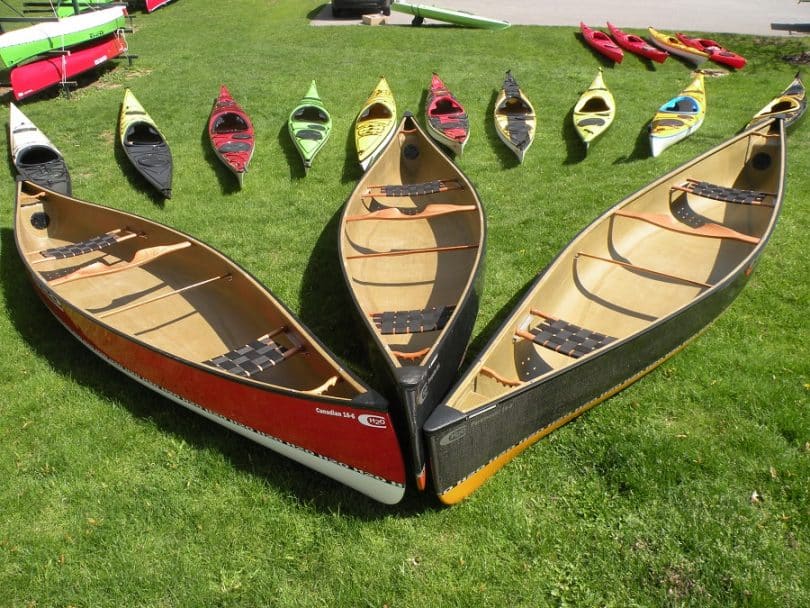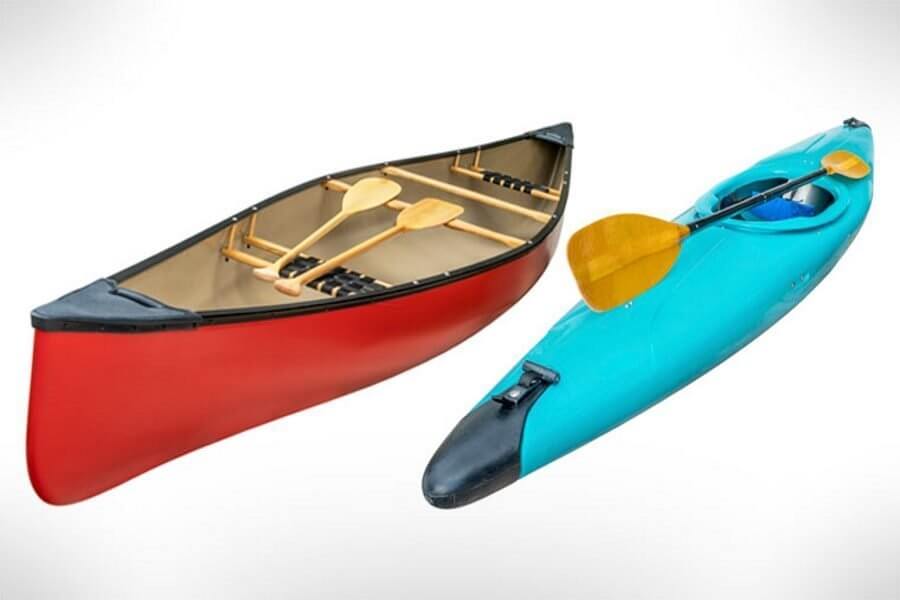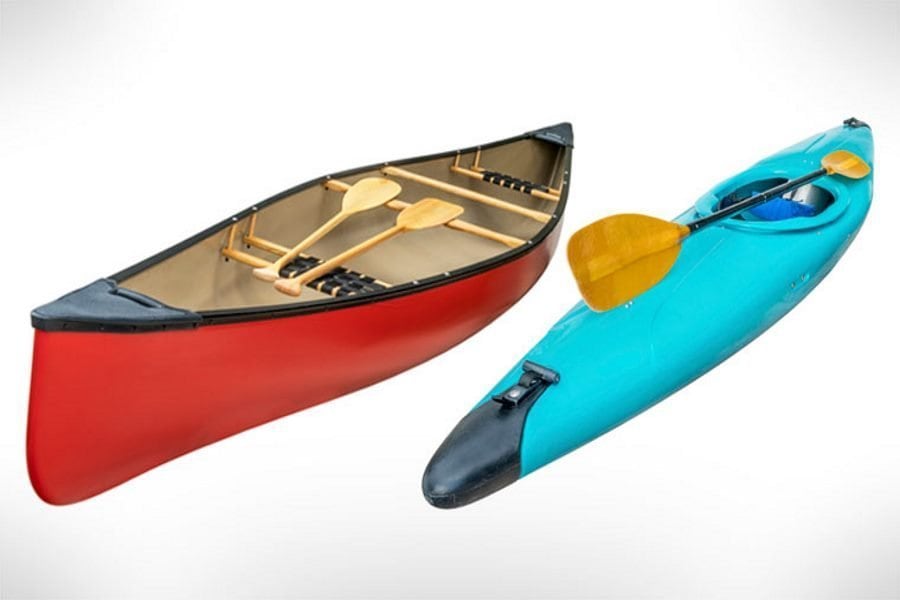Introduction
Embarking on a water adventure stirs a sense of excitement and tranquility, whether it’s gliding through serene waters in a kayak or navigating a river in a canoe. These two classic watercrafts have been the vessel of choice for countless outdoor enthusiasts, each offering a unique way to connect with nature.
Understanding the difference between a canoe and a kayak is essential for those looking to dive into the world of paddlesports.
This guide will illuminate the distinctions, from their historical origins to their modern-day uses, ensuring you make an informed decision on which is best suited for your aquatic escapades.

While both canoes and kayaks are steeped in rich history and have evolved over time, they cater to different experiences on the water. Whether you’re drawn to the open design of a canoe for leisurely trips with family and friends, or the sleek, enclosed structure of a kayak for more intense solo adventures, recognizing their unique characteristics is key.
We’ll explore the physical differences, seating positions, paddle types, and intended uses of each vessel, providing a comprehensive understanding that will help you choose the perfect companion for your next journey on the water.
Physical Differences

Canoe
A canoe is characterized by its open deck design, offering a spacious environment that can accommodate more passengers and gear, making it ideal for group outings and extended trips. Canoes tend to be longer and have a higher weight capacity, with some models capable of holding up to 900 pounds, as noted by Goodwave.
Their broader and more stable build allows for a variety of seating arrangements, including the traditional kneeling position, which is conducive to the single-bladed paddle commonly used in canoeing.
Physically, canoes are bulkier and heavier than kayaks, which can make them more challenging to transport. However, this robust construction contributes to their durability and suitability for carrying heavier loads, a trait that has been valued since their inception.
The open design not only facilitates easier entry and exit but also provides paddlers with a higher vantage point, offering better visibility of their surroundings and enhancing the overall experience of exploration and leisure on the water.
Kayak
In contrast, kayaks are designed with a narrower and sleeker profile, providing enhanced maneuverability and speed that appeals to those seeking a more dynamic paddling experience.
The variety of kayak shapes and sizes, ranging from compact recreational models to specialized touring and sea kayaks, cater to a wide spectrum of water conditions and paddler preferences. Kayaks often feature a closed deck, which helps to keep water out, and are equipped with a smaller cockpit or a sit-on-top design, as detailed by Much Better Adventures.
This configuration allows for a lower center of gravity, giving the paddler a closer connection to the water and a more intimate paddling experience.
When it comes to weight capacity, kayaks typically accommodate solo trips or up to three people, with recreational kayaks supporting up to 300-350 pounds.
The streamlined build of a kayak not only aids in swift navigation but also in ease of transport compared to its canoe counterpart.
Despite their lower profile, kayaks are adept at handling a variety of water conditions, from calm lakes to churning seas, thanks to their enclosed decks and the use of spray skirts to prevent water ingress, ensuring a drier and often more exhilarating ride.
Seating Position

Canoe
Canoe seating positions can vary based on the type of canoe and its intended use. Generally, canoes have three primary seating positions:
- Bow (Front) Seat:
- The bow is the front of the canoe.
- The bow seat is typically for the paddler who sits at the front.
- This position is responsible for steering and setting the pace.
- Stern (Back) Seat:
- The stern is the rear of the canoe.
- The stern seat is usually for the paddler sitting at the back.
- The stern paddler provides power and helps with directional control.
- Center Seat:
- Some canoes have a center seat, usually positioned between the bow and stern.
- The center seat allows for solo paddling or additional passengers.
- When paddling solo from the center, it helps to add weight to the front or back to maintain balance.
In some cases, canoes designed for specific purposes may have additional seating positions or modifications. For instance:
- Tandem Canoes: These canoes are designed for two paddlers. The bow and stern seats are for the primary paddlers, and there may be space for a third person or gear in the center.
- Solo Canoes: These canoes are meant for a single paddler. The paddler sits in the center, making it easier to handle the canoe alone.
- Whitewater Canoes: These canoes might have specialized seating positions to provide better control in fast-moving water.
Always check the specific design and features of the canoe you are using, as there can be variations. The seating positions are crucial for maintaining stability, proper weight distribution, and efficient paddling.
Kayak
The seating position in a kayak is markedly different from that of a canoe, with the paddler sitting low in the hull with legs extended forward. This low-seated posture, often below the waterline, contributes to the kayak’s stability and allows for efficient paddling.
Kayakers utilize a double-bladed paddle, which facilitates a smooth and rhythmic stroke, enabling quick maneuvers and consistent propulsion.
The seating arrangement in a kayak is designed to maximize control and minimize water resistance, which is particularly beneficial when navigating through challenging conditions such as whitewater or coastal environments.
Moreover, the kayak’s seating design is complemented by the use of a spray skirt, which seals the cockpit and prevents water from entering the boat.
This feature is essential for maintaining buoyancy and dryness, especially in rough waters. The snug fit of the cockpit and the lower center of gravity also allow kayakers to perform advanced techniques, such as rolls and braces, with greater ease.
Whether opting for a sit-inside kayak for protection against the elements or a sit-on-top model for ease of access, as described by Goodwave, the kayak’s seating position is a defining characteristic that enhances the paddling experience and the vessel’s performance on the water.
Paddles

Canoe
In the realm of paddling, the canoe stands out with its distinctive single-bladed paddle, which is the traditional tool for navigation. The paddler, either seated or kneeling, wields the paddle on one side of the canoe at a time, switching sides to maintain direction or employing a variety of strokes to steer.
This method of propulsion, while effective, often requires a learning curve to master the nuances of control and maneuverability. The design of the canoe, with its open deck and higher profile, complements the vertical paddle strokes and allows for a greater range of motion without interference from the vessel’s sides.
Canoe paddles themselves are typically longer than their kayak counterparts, with a blade on one end and a T-grip handle on the other, as detailed by REI.
This design facilitates the deep, powerful strokes needed to move the larger and often heavier canoe through the water.
The paddler’s elevated position in the canoe not only aids in visibility but also in leveraging strength during each stroke, making it possible to carry more gear and navigate with precision, even in challenging conditions.
Kayak
When it comes to kayaks, the paddle used is a defining feature that enhances the vessel’s maneuverability and performance. A kayak paddle has blades on both ends, allowing paddlers to execute a continuous, alternating stroke without the need to switch sides.
This dual-bladed design enables quick, responsive movements and a balanced effort across both sides of the kayak. The efficiency of the kayak paddle is further amplified by the paddler’s seated position, which is low to the water, providing a stable center of gravity and the ability to make bracing strokes on either side to prevent capsizing.
The kayak’s streamlined shape and the paddle’s design work in tandem to cut through water and wind with ease, making it a preferred choice for activities that demand agility and speed, such as whitewater kayaking and sea touring.
Additionally, the kayak paddle’s two-bladed configuration allows for a variety of paddling techniques that can be quickly adapted to changing conditions. Skilled kayakers can use these techniques to navigate efficiently through turbulent waters or maintain stability in choppy seas.
The ability to perform bracing strokes with a kayak paddle is particularly advantageous in maintaining balance, as highlighted by the insights on Outdoors Stack Exchange.
This versatility, combined with the kayak’s low profile and covered deck, makes it an excellent choice for adventurers seeking to tackle diverse water environments with confidence and control.
Intended Use

Canoe
Canoeing offers a serene and traditional paddling experience, often associated with tranquil exploration and the ability to transport significant loads. The open design of a canoe, with its lack of a fixed deck and tall sides, makes it ideal for carrying bulky gear or even harvested game, as it can accommodate up to 900 pounds.
This characteristic, as noted on Outdoors Stack Exchange, lends itself to a variety of uses, from leisurely paddles on calm lakes to multi-day river expeditions where ample storage and ease of access to equipment are paramount.
Moreover, the canoe’s design, with its wider hull and higher profile, provides a stable platform for activities such as fishing and hunting, where movement within the boat is necessary.
The versatility of a canoe is also evident in its adaptability to different propulsion methods, including paddles, sails, motors, or even poles, making it a multifaceted vessel for a broad range of water-based pursuits.
Despite its bulkier build, which can make transportation more challenging, the canoe remains a popular choice for those who prioritize space, comfort, and the capacity to carry heavier loads on their aquatic adventures.
Kayak
Kayaks are engineered for a variety of water activities, each design catering to specific conditions and preferences. Whitewater kayaks, for instance, are compact and robust, built to navigate the tumultuous rapids of river settings.
Their agility and quick maneuverability make them the go-to choice for thrill-seekers aiming to conquer fast-moving waters.
On the other hand, touring kayaks, also known as sea kayaks, are crafted for endurance and stability in open waters. These vessels are longer, often exceeding 12 feet, and come equipped with ample storage for extended trips, making them suitable for serene explorations on lakes or coastal journeys.
The sit-in design of touring kayaks, as detailed by Good Wave, offers paddlers protection from the elements and enhances the kayak’s overall stability, a testament to their suitability for calm water expeditions.
For those who prefer a more casual and accessible paddling experience, sit-on-top kayaks present an open deck design that allows for easy entry and exit, ideal for recreational use and perfect for beginners or warm climates. Inflatable kayaks add another layer of convenience with their portability and ease of storage, appealing to those with limited space or who frequently travel.
Regardless of the type, kayaks are synonymous with adaptability, offering a range of options to suit the diverse needs of water enthusiasts. Whether it’s the excitement of navigating through rapids or the tranquility of a coastal paddle, there’s a kayak out there to match the adventure, as affirmed by the experts at Good Wave.
Conclusion

In conclusion, the choice between a canoe and a kayak hinges on the individual’s preferences, the nature of the water adventure, and the specific requirements of the journey.
Canoes offer spaciousness and versatility for those who value comfort and the ability to carry more gear, making them ideal for leisurely trips and expeditions that demand greater load capacity.
Kayaks, with their variety of designs, cater to a wide spectrum of activities, from adrenaline-fueled whitewater challenges to peaceful paddles in open waters, providing options for both the avid adventurer and the casual paddler.
Ultimately, whether you seek the thrill of navigating rapids or the calm of gliding over a glassy lake, understanding the differences between these two vessels will guide you to the perfect watercraft for your next aquatic escapade.
At Good Wave, we are committed to helping you make an informed decision, ensuring that your time on the water is as enjoyable and fulfilling as possible.
With our extensive selection and expert advice, you can confidently choose the right canoe or kayak to suit your lifestyle and embark on a memorable journey across the water.
Remember, whether you’re a seasoned paddler or a beginner, the waterways await with endless possibilities for discovery and delight.
So, paddle forth and embrace the unique experiences that only canoeing and kayaking can offer.
Sources:
- https://www.quora.com/What-are-the-similarities-and-differences-between-a-kayak-and-a-canoe
- https://www.goodwave.co/blogs/parenting-in-the-wild/canoe-vs-kayak-how-they-re-different-and-which-one-is-right-for-you
- https://www.muchbetteradventures.com/magazine/canoe-vs-kayak-whats-the-difference/
- https://outdoors.stackexchange.com/questions/20424/what-is-the-difference-between-a-canoe-and-a-kayak
- https://www.canoeicf.com/canoe-kayak-difference
FAQ
-
Is it easier to kayak or canoe?
The open deck of a canoe means that many first-time paddlers feel more at ease in a canoe than a kayak, but both have their advantages and challenges. Kayaks are more nimble, easier to manoeuvre and can travel faster. But canoes are more stable and spacious.
-
Is a kayak or canoe better for a family?
If you see yourself paddling with someone else most of the time, or with more than one child, then a canoe is a better option. A 16 or 17-foot canoe can easily fit a family of five for a day trip if the kids are small. While there are tandem kayaks, they’re limited to two people comfortably.
-
Is a canoe better than a kayak in rough water?
When it comes to stability, canoes are generally more stable than kayaks due to their wider and flatter hulls. Canoes also offer more room for gear and passengers, making them a better choice for longer trips. However, kayaks are more maneuverable and offer better performance in rough water or waves.
-
Is it better to fish out of a kayak or canoe?
The better option really depends on your personal preference and what kind of fishing experience you want to have. Some people prefer the versatility of a canoe. It can hold more people and is more comfortable for long periods on the water. Others prefer the gear options and stability of a fishing kayak.

